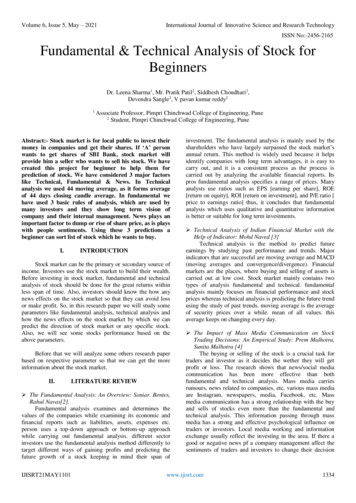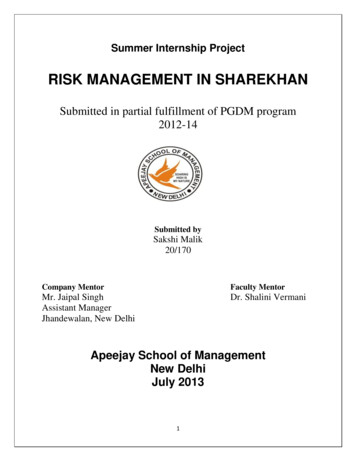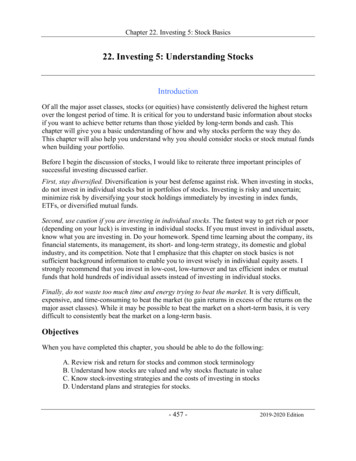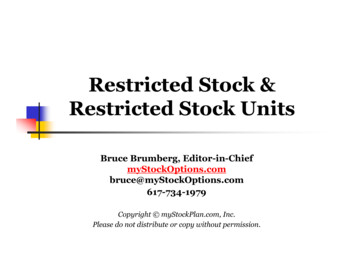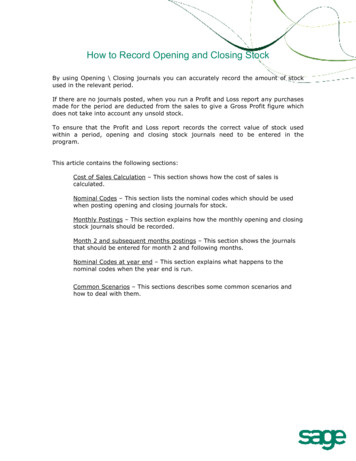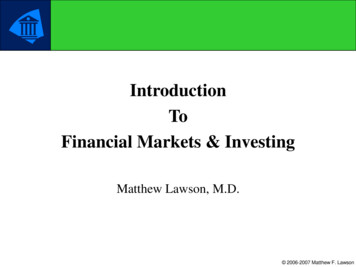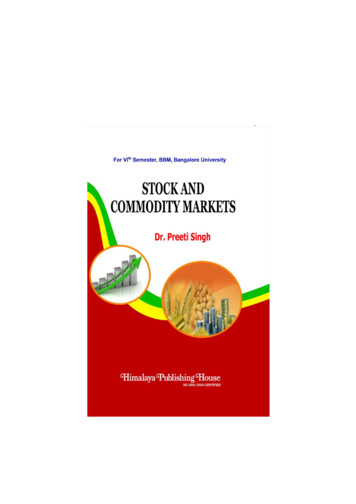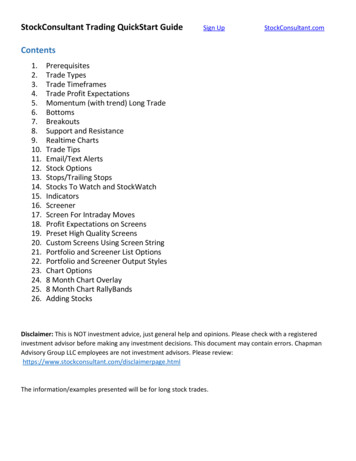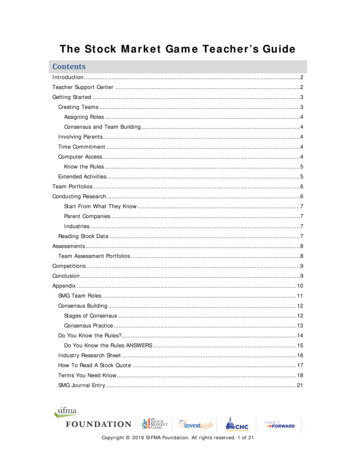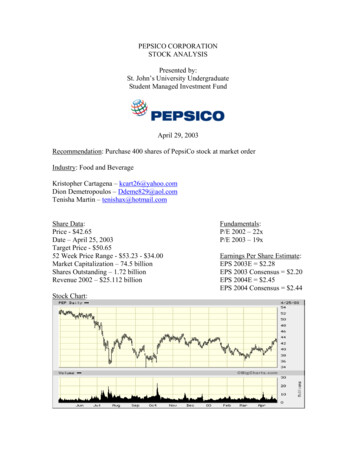
Transcription
PEPSICO CORPORATIONSTOCK ANALYSISPresented by:St. John’s University UndergraduateStudent Managed Investment FundApril 29, 2003Recommendation: Purchase 400 shares of PepsiCo stock at market orderIndustry: Food and BeverageKristopher Cartagena – kcart26@yahoo.comDion Demetropoulos – Ddeme829@aol.comTenisha Martin – tenishax@hotmail.comShare Data:Price - 42.65Date – April 25, 2003Target Price - 50.6552 Week Price Range - 53.23 - 34.00Market Capitalization – 74.5 billionShares Outstanding – 1.72 billionRevenue 2002 – 25.112 billionStock Chart:Fundamentals:P/E 2002 – 22xP/E 2003 – 19xEarnings Per Share Estimate:EPS 2003E 2.28EPS 2003 Consensus 2.20EPS 2004E 2.45EPS 2004 Consensus 2.44
MEMORANDUMTO:Student Managed Investment FundSt. John’s UniversityFROM:Kristopher CartagenaDion DemetropoulosTenisha MartinDATE:April 29, 2003SUBJECT:ANALYSIS OF PEPSICO STOCK AS AN UNDERVALUEDSECURITYThis is the research report that was requested on January 23, 2003 about PepsiCo stockand whether it should be incorporated in to the Student Managed Investment Fund. Theanalysis was done primarily through secondary research. The analysis revealed thatPepsiCo’s stock is currently undervalued at 42.65, as of April 25, 2003.We used a relative valuation model, and determined PepsiCo’s target price to be 50.65.In addition, we used a multi-stage dividend discount model, and determined the stock’sintrinsic value to be 56.83. PepsiCo’s current price of 42.65 is lower than both ourtarget price and its intrinsic value. This confirmed our belief that the stock wasundervalued. We also analyzed the company’s management strategies, financial data,products, performance in its markets, as well as other business indicators of the health ofa company.After conducting a complete analysis of the stock, we recommended:1. Purchase 400 shares of PepsiCo stock at market order2. Incorporate PepsiCo stock into the Student Managed Investment FundWe are grateful for the opportunity of researching this security, and providingrecommendations.For additional information, or answers needed for any questions, you can contact us viae-mail. Our e-mail addresses are listed on the first page of this report.2
TABLE OF CONTENTSTRANSMITTAL MEMORANDUM .2EXECUTIVE SUMMARY .5COMPANY OVERVIEW .6Frito-Lay North America and Frito-Lay International 6Pepsi-Cola North America and PepsiCo Beverages International .7Gatorade/Tropicana North America 8Quaker Foods North America .9MANAGEMENT .9Officers 9Management Strategies .10Flexible Distribution System .11PEPSICO’S RECENT NEWS .11Projected Volume and Revenue Growth for 2003 .11Pepsi Unveils a New Look .12Pepsi Weighs Vanilla Option .12Pepsi Electrifies Summer with Mountain Dew Live Wire .12INDUSTRY ANALYSIS .13Industry Overview .13Food and Beverage Restructuring .13Beverage Industry .14Snack Food Industry .15Analysis of Competitive Forces .15Michael Porter Method of Analysis .16Analysis of Management Strategies Relative to the Food and Beverage Industry18Relative Industry Valuation .19FUNDAMENTAL ANALYSIS 20Ratio Analysis 20Historical Pattern of Ratios 26DuPont Analysis 27Risk Factors .28Investment Drivers .29TECHNICAL ANALYSIS 303
One Year Chart .30Two Year Chart .31Five Year Chart .32Ten Year Chart .33Williams Percentage R .34CONCLUSIONS .34RECOMMENDATIONS .35PEPSICO AT A GLANCE 35LIST OF SOURCES .36LIST OF FIGURESFigure1. Division Net Sales Contribution .102. World’s Leading Food and Beverage Companies .133. PepsiCo Inc. .164. Monthly-Daily Chart of Soft Drink Industry vs. S&P 500 Index .195. 1-Year Daily Chart of the Food & Beverage Industry vs. S&P 500 Index .206. One Year Chart .307. Two Year Chart .318. Five Year Chart .329. Ten Year Chart .3310. Williams Percentage R .344
EXECUTIVE SUMMARYPurpose of the ReportThe purposes of this research report are to (1) introduce PepsiCo and inform the readeron its operations, (2) determine if PepsiCo’s stock is undervalued at 42.65, and (3)determine whether PepsiCo should be purchased for the Student Managed InvestmentFund.The information in this report was gathered through secondary sources, including Internetresearch, information from Multex Fundamentals (a periodical), the 2000 and 2002annual reports from PepsiCo, and PepsiCo’s 10K.PepsiCoPepsiCo’s major dealings include the creation and distribution of convenient foods andbeverages. It is comprised of four major divisions. They are Frito-Lay, Pepsi-Colabeverages, Gatorade/Tropicana, and Quaker Foods. Each division has its own line ofproducts and their own international markets.Analysis of PepsiCo StockPepsiCo is financially healthy and among the industry leaders in financial performance.The ratio analysis confirms this. In addition, PepsiCo’s stock is currently undervalued.Its current price of 42.65 is lower than the target price for the company, 50.65, and theintrinsic value, 56.83. The technical analysis also displays that the stock could beentering a potential upward trend.RecommendationBased on this analysis, we recommend the purchase of 400 shares of PepsiCo stock at themarket order. We recommend the purchase because (1) PepsiCo’s stock is undervaluedat 42.65, (2) it is a diversified company with the ability to generate substantial, and (3) itwill be a good addition to the Student Managed Investment Fund, adding to the fund’sdiversity.5
PEPSICO CORPORATIONSTOCK ANALYSISCOMPANY OVERVIEWPepsiCo is a world leader in convenient foods and beverages, with revenues of about 25billion and over 143,000 employees. The company consists of (1) the snack businessesof Frito-Lay North America and Frito-Lay International, (2) the beverage businesses ofPepsi-Cola North America and PepsiCo Beverages International, (3) Gatorade/TropicanaNorth America juice products, and (4) Quaker Foods North America, manufacturer andmarketer of ready-to-eat cereals and other food products. PepsiCo brands are available innearly 200 countries and territories. Many of PepsiCo’s brand names are over 100-yearsold, but the corporation is relatively young. PepsiCo was founded in 1965 through themerger of Pepsi-Cola and Frito-Lay. Tropicana was acquired in 1998 and PepsiComerged with The Quaker Oats Company, including Gatorade, in 2001.PepsiCo (symbol: PEP) is a publicly traded company. Its shares are traded principally onthe New York Stock Exchange in the United States. The company is also listed on theAmsterdam, Chicago, Swiss and Tokyo stock exchanges. PepsiCo has consistently paidcash dividends since the corporation was founded in 1965. It currently pays 0.60 pershare in dividends to its stockholders. The stock currently trades at 41.84 as ofMonday, April 21, 2003.PepsiCo World Headquarters is located in Purchase, New York, approximately 45minutes from New York City. Edward Durrell Stone designed the seven-buildingheadquarters complex. The building occupies ten acres of a 144-acre complex thatincludes the Donald M. Kendall Sculpture Gardens, “a world acclaimed sculpturecollection in a garden setting” designed by Russell Page (Enrico 2).PepsiCo’s success is the result of superior products, high standards of performance,distinctive competitive strategies and the high integrity of its people. The corporation’smission statement is as follows:“Our mission is to be the world’s premier consumer products company focused onconvenience foods and beverages. We seek to produce healthy financial rewards toinvestors as we provide opportunities for growth and enrichment to our employees, ourbusiness partners and the communities in which we operate. And in everything we do, westrive for honesty, fairness and integrity.”Frito-Lay North America and Frito-Lay InternationalPepsiCo’s snack food operations had their start in 1932, in San Antonio, Texas. It wasthere that Elmer Doolin bought the recipe for the Fritos brand corn chip, and started hisfirm, the Frito Company. In that same year in Nashville, Tennessee, Herman W. Laystarted his own business distributing potato chips. Mr. Lay later bought the company thatsupplied him with product and changed its name to H.W. Lay Company. The Frito6
Company and the H.W. Lay Company merged in 1961 to become Frito-Lay, Inc. Today,Frito-Lay brands account for more than half of the United States snack chip industry. Itproduces eight of the ten biggest-selling salty snacks in the United States (PepsiCoAnnual Report 5).PepsiCo began its international snack food operations in 1966. Today, with operations inmore than 40 countries, it is the leading multinational snack chip company. It accountsfor more than one quarter of international retail snack chip sales. Products are availablein over 120 countries. Frito-Lay North America includes Canada and the United States.Major Frito-Lay International markets include Australia, Brazil, Mexico, the Netherlands,South Africa, the United Kingdom and Spain.Major Frito-Lay products include Ruffles, Lay’s and Doritos brands snack chips. Othermajor brands include Cheetos cheese flavored snacks, Tostitos tortilla chips, Santitastortilla chips, Rold Gold pretzels and SunChips multigrain snacks. Frito-Lay also sells avariety of snack dips and cookies, nuts and crackers. The company markets Frito-Laybrands on a global level, and introduces unique products for local tastes.Frito-Lay North America (FLNA) produced very solid results, building on its position asthe industry leader in salty snacks while pursuing new opportunities in the broadermarket of foods for people on the go. Volume grew 4% in 2002, revenue increased 4%from 8.216 billion in 2001 to 8.565 in 2002, and operating profit rose by 8% from 2.056 billion in 2001 to 2.216 billion in 2002. Frito-Lay International (FLI) postedsolid growth despite the challenge of difficult conditions in several important markets.Volume grew 6% in 2002, revenue increased 4% from 5.492 billion in 2001 to 5.713billion in 2002, and operating profit rose 20% from 651 million in 2001 to 781 millionin 2002. Frito-Lay holds a 59% market share in the United States Snack Chip Industry.Pepsi-Cola North America and PepsiCo Beverages InternationalCaleb Bradham, a New Bern, North Carolina druggist founded PepsiCo’s beveragebusiness at the turn of the century. He first formulated Pepsi-Cola in 1898. Todayconsumers spend about 33 billion on Pepsi-Cola beverages. Brand Pepsi and otherPepsi-Cola products, including Diet Pepsi, Pepsi-One, Mountain Dew, Slice, Sierra Mistand Mug brands, account for nearly one-third of total soft drink sales in the United States,a consumer market totaling about 60 billion. The company provides fountain beverageproducts to certain restaurant chains, such as Pizza Hut, and fast-food restaurants, such asTaco Bell. Pepsi-Cola also offers a variety of non-carbonated beverages, includingAquafina bottled water, Fruitworks and All Sport.In 1992 Pepsi-Cola formed a partnership with Thomas J. Lipton Co. Today Lipton is thelargest selling ready-to-drink tea brands in the United States. Pepsi-Cola also marketsFrappuccino ready-to-drink coffee through a partnership with Starbucks. In 2001 Sobebecame a part of Pepsi-Cola. Sobe manufactures and markets an innovative line ofbeverages including fruit blends, energy drinks, dairy-based drinks, exotic teas and other7
beverages with herbal ingredients. Outside the United States, Pepsi-Cola soft drinkoperations include the business of Seven-Up International.Pepsi-Cola began selling its products internationally in 1934 with its operations inCanada. In addition to brands marketed in the United States, its major products includeMirinda and Pepsi Max. Pepsi-Cola North America includes the United States andCanada. Key international markets include Argentina, Brazil, China, India, Mexico,Philippines, Saudi Arabia, Spain, Thailand and the United Kingdom. PepsiCo BeveragesInternational also produces, sells and distributes Gatorade sports drinks as well asTropicana and other juices internationally.Pepsi-Cola also provides advertising, marketing, sales and promotional support to PepsiCola bottlers, such as the Pepsi Bottling Corporation, and food service customers.Pepsi-Cola North America (PCNA) posted solid gains in the marketplace and generatedhealthy financial results as it displayed strength across the spectrum of beveragecategories. Volume grew 2% in 2002, revenue was up 6% from 3.189 billion in 2001 to 3.365 billion in 2002, and operating profit increased 12% from 881 million in 2001 to 987 million in 2002. PepsiCo Beverages International (PBI) produced very solid resultsby continuing to pursue a highly focused growth strategy. Volume grew 5% in 2002,revenue increased 1% from 2.012 billion in 2001 to 2.036 billion in 2002, andoperating profit jumped 23% from 212 million in 2001 to 261 million in 2002.PepsiCo Beverages International produced these results despite political andmacroeconomic challenges in many markets, including a boycott of American brands inthe Middle East and particularly weak local macroeconomic conditions in Latin America.Pepsi-Cola has a 35% market share in the United States Carbonated Soft Drink Industry,second only to Coca-Cola.Gatorade/Tropicana North AmericaTropicana was founded in 1947 by Anthony Rossi as a Florida fruit packaging business.In 1954 Rossi pioneered a pasteurization process for orange juice. The juice wasTropicana Pure Premium, and it became the company’s flagship product. In 1957 itbecame a leading producing of ready-to-serve premium orange juice, and the name of thecompany was changed to Tropicana Products. The company went public in 1957, andwas purchased by Beatrice Foods Co. in 1978. It was acquired by Kohlberg Kravis &Roberts in 1986 and sold to The Seagram Company Ltd. in 1988. Seagram purchased theDole global juice business in 1995. PepsiCo acquired Tropicana, including the Dolejuice business, in August 1998.Tropicana’s principal brands in North America are Tropicana Pure Premium, TropicanaSeason’s Best, Dole Juices and Tropicana Twister. Internationally, principal brandsinclude Tropicana Pure Premium and Dole juices along with Frui’Vita, Lo oza andCopella. Tropicana Pure Premium is the third largest brand of all food products sold ingrocery stores in the United States.8
Gatorade sports drinks were acquired by the Quaker Oats Company in 1983 and becamea part of PepsiCo with the merger in 2001. Gatorade is the first isotonic sports drink. Itwas created in 1965 by researchers at the University of Florida for the school’s footballteam, “The Gators.” Gatorade is now the world’s leading sport’s drink.Gatorade/Tropicana North America (GTNA) generated healthy volume growth overallfor 2002, and more modest gains in revenue and profit. Volume was up 8%, revenuegrew 4% from 3.699 billion in 2001 to 3.835 billion in 2002, and operating profitincreased 1% from 585 million in 2001 to 590 million in 2002.Quaker Foods North AmericaThe Quaker Oats Company was formed in 1901 when several American pioneers in oatmilling came together to incorporate. In Ravenna, Ohio, Henry D. Seymour and WilliamHeston had established the Quaker Mill Company and registered the now famoustrademark. Seymour wanted his product to be a symbol of honesty, integrity andstrength. The figures of a man in Quaker clothes became the first registered trademarkfor breakfast cereal. It remains the hallmark for Quaker Oats today.In Cedar Rapids, Iowa, John Stuart and his son, Robert, and their partner, GeorgeDouglas, operated the largest cereal mill of the time. Ferdinand Schumacher, known as"The Oatmeal King," had founded German Mills American Oatmeal Company in 1856.Combining The Quaker Mill Company with the Stuart and Schumacher businessesbrought together the top oats milling expertise in the country as The Quaker OatsCompany. The first major acquisition of the company was Aunt Jemina Mills Companyin 1926, which is today the leading manufacturer of pancake mixes and syrup.In 1986, The Quaker Oats Company acquired the Golden Grain Company, producers ofRice-A-Roni. PepsiCo merged with The Quaker Oats Company in 2001. Its productsstill have the eminence of wholesome, good-for-you food, as envisioned by the companyover a century ago.Quaker Foods North America (QFNA) posted solid volume gains and strong profits withits portfolio of strong, well-established brands, such as Quaker Oatmeal and Life cereal.Volume increased 2% in 2002, revenue grew 2% from 1.466 billion in 2001 to 1.491billion in 2002, and operating profit surged 21% from 399 million in 2001 to 481million in 2002.A breakdown of each division’s contributions to PepsiCo’s net sales in 2002 is providedin Figure 1.MANAGEMENTOfficersSteven S. Reinemund is the Chairman of the Board and Chief Executive Officer ofPepsiCo, Inc. He is 54 years old with 18 years of service with the company, and has been9
the CEO since 2001. His total annual compensation, including salary and bonuses, is 4,305,885. He has exercised 334,172 options of his stock options in the company.Indra K. Nooyi is the President and Chief Financial Officer of PepsiCo. She is 47 yearsold, with nine years of service with the company. Her total annual compensation,including salary and bonuses, is 2,057,064. She has exercised 56,769 options of herstock options in the company.PepsiCo's principal divisions and officers are: Frito-Lay North America - Abelardo E. Bru is the Chairman and Chief ExecutiveOfficer. He is 54 years old, and has been with the company for 26 years. PepsiCo Beverages & Foods North America - Gary M. Rodkin is the Chairman andChief Executive Officer. He is 50 years old, and has been with the company for 6years. PepsiCo International - Michael D. White is the Chairman and Chief ExecutiveOfficer. He is 51 years old, and has been with the company for 13 years. Frito-Lay International - Rogelio M. Rebolledo is the President and Chief ExecutiveOfficer. He is 58 years old, and has been with the company for 26 years. PepsiCo Beverages International - Peter M. Thompson is the President and ChiefExecutive Officer. He is 56 years old, and has been with the company for 12 years.Figure 1DIVISION NET NA14%QFNAPBIGTNAPCNAFLIFLNASource: PepsiCo Annual Report - 2003Management StrategiesIn 2002, management put forth a number of programs and strategies to improve the workenvironment and atmosphere at all PepsiCo work locations. Three of these programs andstrategies are: Multi-Year Education Program - PepsiCo is dedicated to promoting diversity in bothits product promotion and its employees. This program was launched in 2002 toincrease the awareness of cultural diversity amongst its employees. It is a day-and-a10
half diversity/inclusion training session for all their salaried employees in the UnitedStates.Internal Controls - Management maintains a system of internal controls designed toprovide reasonable assurance as to the reliability of their financial statements, as wellas to safeguard assets from unauthorized use or disposition. The system is supportedby formal policies and procedures, including an active Code of Conduct programintended to ensure employees adhere to the highest standards of personal andprofessional integrity.Open Communication - To promote high ethical standards across a globalorganization, the company tries to ensure that employees have clear lines ofcommunication to inform senior management of potential issues. The company hastelephone "hotlines" for this purpose, which are accessible at no charge to employees.Flexible Distribution SystemManagement has five large-scale distribution systems, enabling PepsiCo to costeffectively distribute a wide range of products. These five distribution systems make upPepsiCo's flexible distribution system. The five distribution systems are: Direct-Store-Delivery - Direct-Store-Delivery systems at Frito-Lay and throughPepsi-Cola bottlers are ideal for products that move through stores quickly, requiredelicate handling, or benefit from careful merchandising. These systems reach morethan 2 million retail customers each week, from the largest club stores to the smallest"mom-and-pop" outlets. Broker-Warehouse - A large Broker-Warehouse distribution system moves Quaker,Gatorade, and Tropicana products to large retail outlets at a lower cost. It also allowsPepsiCo to test new products that are too small for economic distribution via DirectStore-Delivery. National Distribution - a National Distribution system focused on foodservice andvending accounts, gives Frito-Lay, Quaker, Gatorade, and Tropicana access to agrowing channel that few competitors can serve efficiently. "Chilled" Direct-Store-Delivery - a small but growing "Chilled" Direct-StoreDelivery system distributes products requiring refrigeration. Created for Tropicanajuices, it could carry many other products as well. Hybrid - Hybrid systems, using elements of the other distribution systems, enablesPepsiCo to reach large numbers of retailers in emerging markets like India and China.PEPSICO’S RECENT NEWSProjected Volume and Revenue Growth for 2003On February 6, 2003, PepsiCo announced that over the long-term, the company believesit can grow volume and net revenues in the mid-single digits and earnings per share in thelow double-digits. The company reported full year 2002 earnings of 1.96 per share onrevenues of 25.1 billion. In addition, the Dow Jones reported that the company expectsto meet analysts' estimates for the full year 2003. Wall Street analysts on average areexpecting the Company to earn 2.20 per share on revenues of 26.36 billion in the full11
year 2003 and 2.44 per share on revenues of 27.82 billion in the full year 2004,according to Multex.On March 4, 2003, PepsiCo confirmed that, for the full year 2003, it expects to growvolume and revenue in the mid-single digit range and earnings per share in the lowdouble-digit range. According to Multex, analysts came to a consensus that the companywould report earnings per share of 2.20 in the same period.Pepsi Unveils a New LookPepsi has introduced updates, bolder-looking package graphics for Pepsi-Cola andCaffeine Free Pepsi-Cola. This is going to give Pepsi a new, more modern look. Pepsi isadapting to a youthful attitude mixed with boldness and excitement. The new lookcapitalizes on Pepsi’s “globe” which is one of the word’s most recognizable icons. Pepsiis making the “globe” larger and more pronounced. The word “Pepsi” is printed in abolder, more stylized font with a touch of silver for more contemporary look and feel.Ice shards highlight the blue background to give it a more three-dimensional look. Onthe cans, the word “Pepsi” is written across the top instead of along the side.Pepsi Twist and Diet Pepsi Twist, the popular lemon-flavored versions of Pepsi and DietPepsi also are going to have a new look. Pepsi Twist and Diet Pepsi Twist now have adistinctive yellow band. They also have enhanced their tastes with more lemon flavoradding to its already successful product.Whenever a product changes its look the consumers realize this and want to purchase this“new product”. The marketing department of Pepsi did research on what to do in order tospice up their already stabilized product. Pepsi’s look has been well known for manyyears, and being that they wanted to boost revenues, they combined these two thoughtsand came up with changing its look. When a product changes something slightly, it addsreason to advertise the product and places it in the consumer’s mind. This should stir upsome new sales for Pepsi.Pepsi Weighs Vanilla OptionCoca-Cola had come out with a new product called Vanilla Coke in 2002. So far CocaCola has been successful with this new product. Due to the high feud with Coca Cola,Pepsi wants to counteract this new product with their own product of Pepsi Vanilla. Theproduct includes the original Pepsi-Cola flavor with a hint of Vanilla flavoring. PepsiVanilla is currently being tested in selected test markets across the country. It is expectedto make its national debut by the end of the summer in 2003. PepsiCo plans to have astrong marketing campaign behind its new product.Pepsi Electrifies Summer with Mountain Dew Live WireFrom Memorial Day 2003 through Labor Day, Pepsi-Cola will offer Mountain Dew LiveWire, which is an orange-ignited new Dew, to consumers across the United States.Combining the unique citrus taste of Mountain Dew with a bold orange flavor, Mountain12
Dew “Live Wire” initially will be available in 20-ounce plastic bottles, with plans toexpand into two-liter plastic bottles and 12-packs of 12-ounce aluminum cans. MountainDew “Live Wire” will be targeted to teens and young adults. This new product will beheavily supported by a 3-month marketing plan, including TV, radio, online, outdoor andpoint of sale advertising.INDUSTRY ANALYSISIndustry OverviewThe U.S. food and nonalcoholic beverage industry comprises establishments that processor manufacture foods and beverages for human consumption, plus related products likechewing gum and vegetable and animal fats and oils. According to estimates by the U.S.Department of Agriculture (USDA), total food and beverage expenditures rose 3.8% to 844.2 billion in 2001, from 813.4 billion in 2000. Total expenditures include productsfor consumption at home ( 443.9 billion in 2001) and away from home ( 400.3 billion).Figure 2 displays the world’s leading food and beverage companies according to sales in2002. PepsiCo is ranked fourth behind Nestle, Kraft Foods, and Unilever.Figure 2520151050Nestle Sales in BillionsWORLD'S LEADING FOOD ANDBEVERAGE COMPANIESSource: PepsiCo Annual Report – 2003Food and Beverage RestructuringSeveral food companies have undertaken some form of restructuring or realignment inrecent years in an effort to improve volume growth and profitability. These actions, the13
benefits of which are now being fully realized, have addressed the need to cut costs in acompetitive marketplace that leaves little room for price increases.Food and beverage companies have also targeted logistics and supply chain costs forimprovement. A number of business-to-business (B2B) electronic marketplaces havebeen launched to aid these efforts. These marketplaces allow buyers and sellers ofsimilar goods to carry out procurement activities over the Internet. They may helpcompanies update business transactions with their suppliers, buyers, and distributors.They may also reduce transaction costs, generate volume-related scale economies bycombining orders from multiple purchasers, improve inventory management, andfacilitate bidding by a broad spectrum of potential suppliers. Given the mature state ofthe U.S. food industry and our expectation for low levels of food price inflation, weexpect that realignment and cost-cutting activities will remain a major focus within theindustry.Beverage IndustryEarnings for major soft-drink companies showed substantial improvement in thefirst three quarters of 2002, and full-year operating earnings increased 7% to 9% onaverage. Companies are still dealing with sluggish carbonated soft drink trends in theUnited States. However, despite higher levels of marketing and promotional spending,and economic weakness in many international markets, noncarbonated beverage productscontinue to drive growth. Operating profits for the beverage industry are projected to rise9%-10% in 2003 reflecting 7%-8% higher North American profits, a strong 14%-15%increase in Gatorade/Tropicana profits and a 4%-5% increase for international beverages.Beverage profits should benefit from a favorably pricing environment.For 2003, modestly higher prices for soft drinks and other beverage products in U.S.supermarkets should boost profits for manufacturers. Noncarbonated drinks shouldcontinue to show strong growth, while volume trends for carbonated beverages shouldcontinue to show improvement. In addition to marketing and promotions, aggressive newproduct introductions by the major manufacturers should also help to boost volumetrends.The projected increases in operating profits for the beverage industry in 2003 will bedriven by a further rise in per capita consumption in the United States and abroad, stronggrowth in sales of new products, lower advertising costs, and modest price increases.The consolidation of bottling networks by both the Coca-Cola Co. and PepsiCo hashelped to reduce retail price competition; after several years of intense pressure, softdrink prices have risen steadily since mid-1999. While raw material costs appear morechallenging than in recent years, most companies are not expecting substantial increasesin their overall cost structure.14
Year to date the S&P Soft Drink Index fell 3.8% versus a 1.4% rise in the S&P 1500.During 2002, the industry index significantly outperformed the broader market with adecline of 8.0% versus a 22.5% de
business at the turn of the century. He first formulated Pepsi-Cola in 1898. Today consumers spend about 33 billion on Pepsi-Cola beverages. Brand Pepsi and other Pepsi-Cola products, including Diet Pepsi, Pepsi-One, Mountain Dew, Slice, Sierra Mist and Mug brands, account for nearly one-third of total soft drink sales in the United States,


